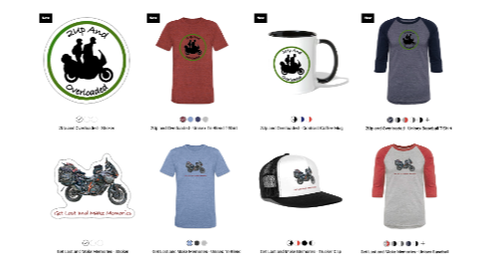KTM 1190 Adventure R
The KTM 1190 R has a few key features that set it apart from its S brother. But after extensively riding both motorcycles, this is my breakdown of the differences, and how they improved our day to day ride for 25k continuous miles on the road.
The two bikes have the same frame, engine, gear ratio, tank size, and fancy ABS and Traction Control modes.
The two main differences are tire size and suspension. The combination of these two factors make riding the R a much more capable off road motorcycle without loosing any comfort while on pavement.
The two bikes have the same frame, engine, gear ratio, tank size, and fancy ABS and Traction Control modes.
The two main differences are tire size and suspension. The combination of these two factors make riding the R a much more capable off road motorcycle without loosing any comfort while on pavement.
1190 Adventure R main differences from the 1190 Adventure S
1. Wheel size: The Adventure R has a 21" front wheel and 18" rear wheel as opposed to the 19/17 on the Adventure S.
Our first true off-road test was on the Arizona BDR, and as we bounced over baby-head rocks, and through loose sandy sections, I could immediately feel the difference between the two motorcycles.
As we crawled our way over obstacles, I was fully aware that as much as my skill have been increasing throughout the years, this new found ease was completely due to the larger wheels tackling the terrain without resistance.
The 1190 S was fully capable of riding off road, and it had taken us across mountain passes in Central Peru, and up single trail donkey trails along cliffside tracks in Africa. But having been ignorantly blissful, I wasn't aware of how much of a difference the larger wheel size could make.
I have not had a flat tire in the first 25k miles (knock on wood). But both the 1190 R and S have tubeless tires that have been simple to plug when a hidden ninja lands a direct hit with a rusty throwing star. Tubeless tires make patching a hole with a cheap tire plug kit and portable tire inflator simple, getting you back on the road in minutes. Both motorcycles have spoked rims that absorb all of the potholes we have encountered both on and off road.
We use Dunlop Trailmax on the front and the rear, and even though there are a thousand different tire combinations that range from a TKC80 on the front for ultimate traction, and a MotoZ Tractionator GPS on the rear. But the Dunlop Trailmax tires are the overall best in show in my experience.
Our first true off-road test was on the Arizona BDR, and as we bounced over baby-head rocks, and through loose sandy sections, I could immediately feel the difference between the two motorcycles.
As we crawled our way over obstacles, I was fully aware that as much as my skill have been increasing throughout the years, this new found ease was completely due to the larger wheels tackling the terrain without resistance.
The 1190 S was fully capable of riding off road, and it had taken us across mountain passes in Central Peru, and up single trail donkey trails along cliffside tracks in Africa. But having been ignorantly blissful, I wasn't aware of how much of a difference the larger wheel size could make.
I have not had a flat tire in the first 25k miles (knock on wood). But both the 1190 R and S have tubeless tires that have been simple to plug when a hidden ninja lands a direct hit with a rusty throwing star. Tubeless tires make patching a hole with a cheap tire plug kit and portable tire inflator simple, getting you back on the road in minutes. Both motorcycles have spoked rims that absorb all of the potholes we have encountered both on and off road.
We use Dunlop Trailmax on the front and the rear, and even though there are a thousand different tire combinations that range from a TKC80 on the front for ultimate traction, and a MotoZ Tractionator GPS on the rear. But the Dunlop Trailmax tires are the overall best in show in my experience.
2. Suspension: Both bikes feature WP fully-adjustable suspension front and rear however the R version's has fully manual preload without any fancy motors that will most likely fail at some point. As loaded as we are, we crank the preload to its stiffest setting and leave it there. One of the most important features of the 1190 R is that the rear monoshock can be upgraded. We had our suspension re-sprung and re-valved at Carl's Cycle Sales in Boise, ID. They fine tuned our suspension for our overloaded stature, and it has been a smooth ride ever since.
I protect the front shock's fork seals with a pair of Dirt Skins. It is a cheap and effective way to keep grime and dirt out of the seals. It is an easy install and they are very durable.
The rear suspension was the only real drawback of our 1190 S. Due to the standard model's electronic suspension, it is not possible to upgrade anything but the spring. This fact alone makes the R a more capable and customizable motorcycle for long distance and heavy abuse.
I protect the front shock's fork seals with a pair of Dirt Skins. It is a cheap and effective way to keep grime and dirt out of the seals. It is an easy install and they are very durable.
The rear suspension was the only real drawback of our 1190 S. Due to the standard model's electronic suspension, it is not possible to upgrade anything but the spring. This fact alone makes the R a more capable and customizable motorcycle for long distance and heavy abuse.
3. Handlebars: The bars on the Adventure R are wider and allow greater leverage while riding off road. It is something that helps without me even noticing any difference in riding comfort compared to the S. The handlebar width, tied in with the suspension and tire size all make off road riding much easier. I protect my hands with a pair of BarkBusters, and replaced my mirrors with a pair of DoubleTake Mirrors. The first time I dropped the KTM 1190 the OEM mirror snapped right off. Ever since I upgraded, I have had a hundred or so falls, and the DoubleTake mirrors just collaps in on themselves and fold back out with ease.
4. Seat: The 1190 Adventure R has a one-piece seat as opposed to the two-piece seat on the 1190 Adventure. I preferred the two-piece seat as it allowed easier access to the compartment under the pillion seat where I stash tools, and important documents. Neither seat was very comfortable after 4 hours on the road, so we use AirHawk seat cushions to make our long riding days more comfortable. A relatively cheap upgrade compared to custom seats, and I we also use a plastic cutting board underneath Marisa's AirHawk to make the seat wider. I am not sure what model they used for pillion's rear ends, but they surely were not thinking of the average pair of buttocks when making the foam mold.
4. Seat: The 1190 Adventure R has a one-piece seat as opposed to the two-piece seat on the 1190 Adventure. I preferred the two-piece seat as it allowed easier access to the compartment under the pillion seat where I stash tools, and important documents. Neither seat was very comfortable after 4 hours on the road, so we use AirHawk seat cushions to make our long riding days more comfortable. A relatively cheap upgrade compared to custom seats, and I we also use a plastic cutting board underneath Marisa's AirHawk to make the seat wider. I am not sure what model they used for pillion's rear ends, but they surely were not thinking of the average pair of buttocks when making the foam mold.
5. Gas Tank: We have only been stranded once based on the KTM 1190's fuel capacity. You can either call it poor planning, or just bad luck, but we puttered to a stop while returning from Deadhorse, Alaska to Coldfoot. We do carry an extra gallon in our Rotopax that is always mounted to our pannier rack. With that, along with proper route planing, the 7 gallons has gotten us from one remote gas station in Argentina to the next.




















